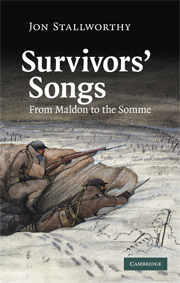Book contents
- Frontmatter
- Contents
- Voice over
- Acknowledgements
- 1 The death of the hero
- 2 Survivors' songs
- 3 England's epic?
- 4 Who was Rupert Brooke?
- 5 Christ and the soldier
- 6 Owen's afterlife
- 7 Owen and his editors
- 8 The legacy of the Somme
- 9 The iconography of the Waste Land
- 10 War and peace
- 11 The fire from heaven
- 12 Henry Reed and the Great Good Place
- 13 The fury and the mire
- Notes
- Index
13 - The fury and the mire
Published online by Cambridge University Press: 06 July 2010
- Frontmatter
- Contents
- Voice over
- Acknowledgements
- 1 The death of the hero
- 2 Survivors' songs
- 3 England's epic?
- 4 Who was Rupert Brooke?
- 5 Christ and the soldier
- 6 Owen's afterlife
- 7 Owen and his editors
- 8 The legacy of the Somme
- 9 The iconography of the Waste Land
- 10 War and peace
- 11 The fire from heaven
- 12 Henry Reed and the Great Good Place
- 13 The fury and the mire
- Notes
- Index
Summary
‘My subject is War, and the pity of War. The Poetry is in the pity.’ That was Wilfred Owen in 1918. My subject, many wars later, is War and the fury of War. The Poetry is in the fury.
Poetry is notoriously difficult to define. ‘Of the many definitions’, said W. H. Auden, ‘the simplest is still the best: ‘memorable speech.’ To be worth writing, and reading, it must be memorable – as so much so-called poetry is not. And what do we mean by War Poetry? Logically, this category – to my mind, this unsatisfactory category – should embrace any poem about any aspect of war: it should include Eliot's Waste Land and Little Gidding; it should include Yeats's ‘The Second Coming’. Each has a World War at its centre, and in the field – the battlefield – of poetry it is hard to think of speech more memorable. But when we speak of War Poetry we normally mean battlefield poems, and my subject in this chapter is the controlled fury of battlefield poems. These, too, can be difficult to define, but we know them when we see – and hear – them: Owen's ‘Dulce et Decorum Est’, for example. What does that poem do? First of all, it persuades us that it is true; secondly, that its truth is shocking; and thirdly, that we should do something about it.
- Type
- Chapter
- Information
- Survivors' SongsFrom Maldon to the Somme, pp. 178 - 195Publisher: Cambridge University PressPrint publication year: 2008



